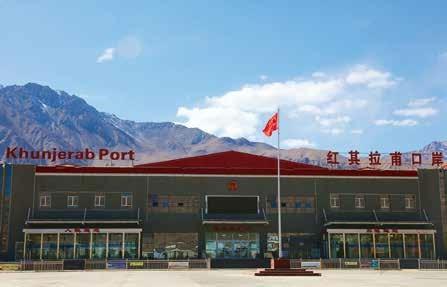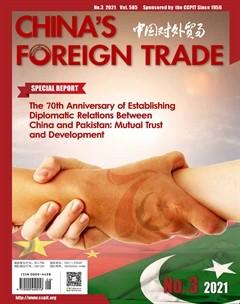The 70th Anniversary of Establishing Diplomatic Relations Between China and Pakistan:Mutual Trust and Development


Developing friendship through generations
On April 21, 2015, the lecture hall of the parliament building in Islamabad, Pakistan, was packed with people. Chinese President Xi Jinping, who was on his first visit to Pakistan, recalled the history of bilateral exchange in his keynote speech: “Since the establishment of formal diplomatic relations, with the concerted efforts of leaders of the two countries, China and Pakistan forged an all-weather friendship and started all-round cooperation thanks to the efforts of the people in all walks of society. No matter how the international climate and domestic situation changed, the two countries have always understood and supported each other on issues involving the core interests of both parties. This bilateral friendship is unique in the world.”
In Islamabad, there are historical markers left by former Chinese leaders. In the embassy area, not far from the parliament building, there is a main road called Zhou Enlai Avenue, the first road in Pakistan to be named after a foreign leader. Looking at the international friendship forest located on Shakebarrian Mountain, southwest of the road, the tall tree, which was planted by premier Zhou Enlai during his second visit to Pakistan, stood high. This is also the first tree planted by any foreign leader in the friendship forest.
Throughout 70 years of turbulence and change, the friendship between China and Pakistan has been solid and unshakable. The government and people of the two countries have shown a strong friendship through their actions.
Pakistans valuable support was indispensable for China to break through the external blockade after its founding in order to restore its legitimate seat at the United Nations; after a strong earthquake hit Chinas Wenchuan county in 2008, Pakistan offered full support to China with all its strategy reserve tents; and when Pakistan suffered from a catastrophic flood in 2010, China sent the largest medical rescue team in history.
After the COVID-19 pandemic broke out, the governments and people of both countries offered support to fight this virus. During the early phase of Chinas fight against the pandemic, Pakistani President Arif Alvi was first to send a letter to President Xi Jinping. Both the senate and the national assembly of Pakistan passed resolutions to firmly support Chinas fight against the pandemic. In summary, the Pakistani government and people made every effort to provide China with masks and other medical supplies to prevent the spread of the virus.
When Pakistan was hit hard by the pandemic, China sent a medical expert team and provided many batches of medical supplies. As China has seen successes in the R&D of the COVID-19 vaccine, Pakistan became the first country that received vaccines donated by China. The Pakistani army was also the first foreign army that received Chinese vaccines.
Build economic corridors together
“The China-Pakistan Economic Corridor is an important vehicle for both countries to achieve development. We shall acknowledge the leading role of the construction of the economic corridor to the cooperation between the two countries,” Chinese President Xi Jinping said about the construction of the economic corridor six years ago.
As a landmark project of the Belt and Road Initiative, construction on the China-Pakistan Economic Corridor started in 2013. In 2015, the two countries formulated a “1 + 4”working plan with regards to corridor construction as the center and Gwadar Port, energy, infrastructural construction and industrial cooperation as the focus.
At the construction site of Suki Kinari hydropower project in Pakistan, which has just completed second phase dam closure, workers are stepping up construction. As one of the priority projects of the China-Pakistan Economic Corridor, this hydropower station is expected to be completed in December, 2022, and will provide 3.212 billion kwh of clean power to Pakistan every year after it is fully operating.
At the Sahiwar coal-fired power plant in the central part of Punjab province, power engineer Tanvir and his Chinese colleagues have been working at the central control room, all wearing masks. Since the outbreak of the COVID-19 pandemic, strict virus prevention measures have ensured zero infection at the plant. As the largest energy project under the framework of the economic corridor, the two units of the power plant have generated more than 30 billion kwh of electricity.
“The energy projects of the economic corridor, including the Sahiwar coal-fired power plant, have provided electric power for Pakistan,” said Tanvir.
Driving on the second phase of the Karakoram Highway (Hevalian to Thakot), Israar, who works in the transportation business, is enjoying a smooth and comfortable journey. As a major transportation project that is part of the economic corridor, the Karakoram Highway, which was constructed by a Chinese company, will be fully open to traffic at the end of July 2020. The original 5.5-hour driving time will be shortened to less than 2 hours.
“The journey time has been largely reduced. This will raise my income and also reduce costs of oil and vehicle maintenance,” said Israar.
At the port of Gwadar, the port and free zone are in operation, with the ship whistle blowing. At the Gwadar New International Airport, China-Pakistan Friendship Hospital, vocational and technical training school, East Gulf Expressway and other projects, workers from both countries have been working hard. The Gwadar Port is making steady progress towards becoming a regional logistics hub and industrial base.
In total there are about 70 projects that fall under the framework of the economic corridor, with 46 projects already under construction or completed.
“The economic corridor has solved the problem of energy shortage in Pakistan, created 75,000 new jobs, and connected all parts of Pakistan through modern transportation infrastructure.”Hossain, Chairman of the Foreign Affairs Committee of the Pakistani Senate, said, “the Belt and Road Initiative has promoted social and economic development in Pakistan, and opened up a world of inter-connectivity.”
Nong Rong, Chinese Ambassador to Pakistan, said that since the launch of the China-Pakistan Economic Corridor, China has become Pakistans largest trading partner, and has been so for six consecutive years. China has also been the largest source of investment for seven consecutive years. The corridor has brought USD 25.4 billion worth of direct invest- ment to Pakistan.
After the second phase of the China-Pakistan free trade agreement came into effect, the level of trade liberalization between the two countries has improved greatly. According to statistics from Chinas Ministry of Commerce, Chinas imports from Pakistan reached USD 2.12 billion in 2020, a year-on-year increase of 17.5%.
So far the Pakistani government has set up nine special economic zones. The Rashakai special economic zone, which was constructed by companies of both China and Pakistan, is one of them. Located in the Khyber Pakhtunkhwa Province, the economic zone will attract companies of both countries to expand industrial cooperation, build a manufacturing center and create more jobs.
Pakistans China-Pakistan Economic Corridor Affairs Bureau director Bajwa said that the China-Pakistan Economic Corridor has filled gaps in Pakistans energy sector, communication sector and others. It will create more employment and investment opportunities through wider cooperation in industrialization and agricultural production, so that corridor construction can benefit more people.
Agricultural cooperation and the construction of industrial parks are key
Pakistani President Arif Alvi said that the China-Pakistan Economic Corridor is the focus of Pakistans cooperation with China. The construction of the corridor not only strengthens Pakistans domestic and regional connectivity, but also alleviates infrastructural weaknesses such as the energy shortage. Now, as the construction of the China Pakistan Economic Corridor enters the second stage, there will be more projects that promote Pakistans industrial development and improve peoples livelihoods.
He said, “the China-Pakistan Economic Corridor aims to meet power demands through the construction of power plants, reducing poverty, improving education, creating jobs, stimulating the industry and establishing special economic zones that will attract foreign investment. Cooperation has now extended from the energy sector to social areas. The power plants we built are able to empower factories, which will create job positions for local people. We are also improving the function of social departments and learning Chinas successful experience in reducing poverty.”
Nong Rong said that agriculture and industry are the top concerns of Pakistan, which is also the areas in which bilateral cooperation has the most promising future.
Both countries have made rapid progress in agricultural cooperation. The first project was to enhance the mechanisms. Last year, both parties established an agricultural working team under the framework of the China-Pakistan Economic Corridor Organizing Committee. The working teams first job is to help Pakistan fight against the plague of locusts and achieve positive results.
The second project was to speed up the export of agricultural products to China. The inspection and quarantine procedures for Pakistans onions, potatoes, cherries, dairy products and other agricultural products exported to China are underway. This year, the protocol on the onion export to China will be signed, and nine Pakistani rice export enterprises will be newly registered. On top of that, the establishment of foot-and-mouth disease free areas in Pakistan will be steadily implemented.
The third project is promoting investment. This year, with the strong promotion of Chinas Embassy in Pakistan, China and Pakistan have established an agricultural industry cooperation information platform, to promote all-round communication and cooperation of the political, business and academic sectors. Chinese enterprises are also planning to invest in pepper plantations, buffalo milk, food processing and other agricultural machinery businesses in Pakistan.
Nong Rong said that new progress has also been made in industrial cooperation. “The Gwadar free trade zone has attracted more than 40 businesses including hotels, banks, metal processing, overseas warehouses and grain and oil processing businesses. Total investment has amounted to more than RMB 3 billion. In 2020, Rashakai Special Economic Zone, the first industrial park under the framework of the China-Pakistan Economic Corridor, saw the signing of a park development agreement, and the imported equipment of the first stationed steel enterprise arrived at the Karachi Port. In addition, both parties have been strengthening cooperation in textile, auto, energy and telecommunication industries. The bilateral industrial cooperation is moving towards diversification, wisdom and high added value.”
In order to alleviate Pakistans trade deficit against China, China has taken a series of positive measures over the years. First, the second-phase protocol of the China-Pakistan Free Trade Agreement was enforced on January 1, 2020, with 75% of traded goods between the two countries enjoying zero tariff; Second, the countries carried out inspection and quarantine cooperation, and strived to promote the entry of Pakistans high-quality agricultural products such as cherries, onions, potatoes, beef and mutton into the Chinese market; Third, facilitation of participation of Pakistani enterprises in CIIE (China International Import Expo), Canton Fair, ASEAN Expo and other key exhibitions; Fourth, encouraging Chinese enterprises to invest in Pakistan and improve the export earning capacity of Pakistani enterprises. China will continue to take multiple measures to promote a more balanced development of China-Pakistan trade.
Working together to fight the pandemic
During the difficult time when China fought against the pandemic, Pakistan donated all its reserves to support Chinas efforts to fight against the pandemic. It also opposed politicizing the pandemic or stigmatizing China. After the spread of the pandemic to Pakistan, the Chinese government, the military, local governments, enterprises and social organizations joined hands to continuously deliver medical supplies to Pakistan. China also sent two medical expert groups to share medical experiences and virus control techniques with Pakistan. The two countries also established a joint prevention and control cooperation mechanism to ensure Pakistans economic operation and recovery during the pandemic.
Nong Rong said that at present, Pakistan is facing the impact of the third wave of pandemic, and China has attached great importance to bilateral cooperation in vaccines. “Both the Chinese government and the military regard Pakistan as the first target country to offer vaccine assistance, and Chinese enterprises have been working closely with their Pakistani counterparts. Pakistan is also the country that has been most open to Chinas vaccines. It has been actively involved in the third-phase vaccine trials of Chinese companies and made important contributions to R&D and usage of Chinese vaccines. For example, about 45% of foreign participants in phase III vaccine trials of CanSino Biologics Inc. are from Pakistan. The Pakistani government has already approved emergency use of vaccines of three Chinese companies, and two other Chinese companies are conducting phase III clinical trials in Pakistan. With the support of Pakistan, Chinese personnel in Pakistan have completed the inoculation of the Chinese vaccines, taking the lead in completing the spring vaccine program. It can be said that cooperation between China and Pakistan in the fight against the pandemic has set a good example to the world. Both countries will continue to carry out indepth cooperation in fighting the pandemic,” said Nong Rong.
- China’s foreign Trade的其它文章
- CCPIT Holds Conference to Review Poverty Alleviation and Encourage Effective Link-up of Poverty Alleviation Achievements and Rural Revitalization
- Message from Adviser to the Prime Minister on Commerce & Investment H.E.Mr.Abdul Razak Dawood
- Message from Ambassador of Pakistan H.E.Mr.Mon-UI-Haque
- Message from Ambassador Extraordinary and Plenipotentiary of the People’s Republic of China to the Islamic Republic of Pakistan H.E.Mr.Nong Rong
- Message from Minister of State/Chairman Board of Investment H.E.Mr.Atif R.Bokhari
- Message from President of the Federation of Pakistan Chambers of Commerce & Industry H.E.Mr.Mian Nasser Hyatt Maggo

